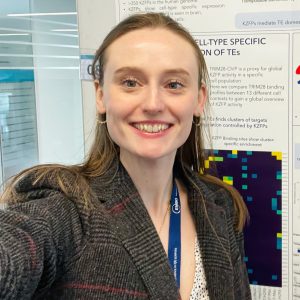Best poster prizes at ‘The mobile genome: genetic and physiological impacts of transposable elements’
In early November (yes, it’s December already! ❄️), the EMBO Workshop ‘The mobile genome: genetic and physiological impacts of transposable elements’ took place in Heidelberg and virtually. It was a great workshop with lots of lively discussions, two amazing keynote speakers, 23 invited speakers, and an outstanding programme featuring two poster sessions. The participants had the opportunity to cast their votes for the best posters, leading to the recognition of three distinguished contributions. While we’re excited to showcase the fantastic work of one winner, we also respect the journey of unpublished data from the other two winners. Take a closer look at the unveiled brilliance, and stay tuned for future reveals when the time is right! 🎉✨
Regulatory activities of transposable elements in elite control of HIV-1
infection
Presenter: Sabrina Leddy

Abstract: Less than 0.5% of people living with HIV-1 are elite controllers (ECs): individuals who have
a replication-competent viral reservoir in their CD4+ T cells but are able to maintain undetectable plasma viremia without the help of antiretroviral therapy (ART). While the EC CD4+ T cell transcriptome has been investigated for gene expression signatures associated with disease progression, the possibility of unique transposable element (TE) activities in ECs has not been explored. Previous studies have established that TEs can directly impact gene expression, including our innate immune response to infections like HIV-1. Thus, we hypothesized that the regulatory activities of TEs could be distinct in ECs and contribute to their natural resistance against HIV-1. Here, we performed a TE-focused meta-analysis on previously published multi-omics data derived from EC individuals and other patient groups. We found that the CD4+ T cell transcriptome and retro-transcriptome of ECs are distinct from healthy controls, ART-treated HIV-1 patients, and treatment-naïve HIV-1 viremic progressors. However, there is still a substantial level of transcriptomic heterogeneity between ECs. We are able to reduce this to four clusters of EC individuals with unique expression profiles of antiviral restriction factors and TE families. Notably, several TE families with known immuno-regulatory activity are differentially expressed and accessible among ECs. Their transcript levels positively correlate with their chromatin accessibility and negatively correlate with the expression of KRAB zinc-finger (KZNF)-encoding genes that bind to and repress them. This type of variation is seen at the level of individual TE loci, likely acting as cis-regulatory elements for nearby upregulated genes, many of which are involved in HIV-1 restriction. Based on these analyses, we believe that the EC phenotype may be driven in part by the reduced ability of their KZNFs to repress specific TEs that serve as cis-regulatory elements for nearby antiviral genes, thereby heightening their resistance to HIV-1 infection. Further investigation into this retrovirus-on-retrovirus control and the role of transposon regulators could assist in the development of novel HIV-1 therapies.
Regulation of transposable elements during mouse preimplantation
development
Presenter: Clara Hermant

Abstract and poster not available due to unpublished data.
Efficiently uncovering the individual roles of KZFPs and domesticated transposable elements with a TRIM28-centric strategy
Presenter: Juliette Davis

Abstract and poster not available due to unpublished data.